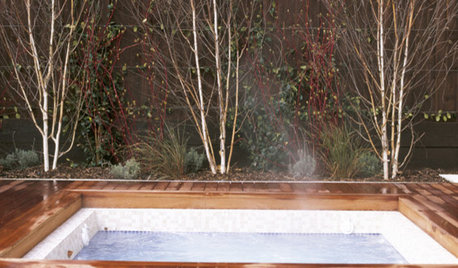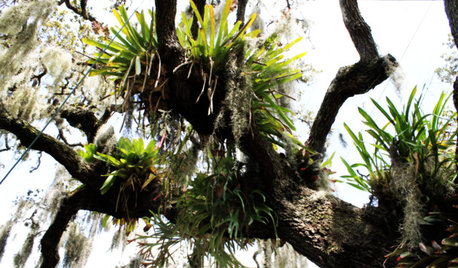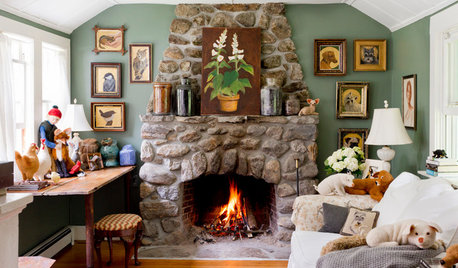Got a few questions for this years veggie gardens :)
sustainabee
7 years ago
Featured Answer
Sort by:Oldest
Comments (6)
lazy_gardens
7 years agoRelated Discussions
HAVE: Mainly flowers, few veggies & herbs, got to go
Comments (8)couldn't really find too much on your list posted .. found this on your trade list.. Golden Sweet Pea Scarlet Beauty Bush Dry Bean Cherokee Wax Bean Top Crop Garden Bean Rattlesnake Beans Harvester Garden Bean...See Moresecond year w/ OGRes have a few questions
Comments (9)I don't know that I would wrap the rose around the fence. I think I would just pull the canes as horizontally as I could and tie them to the fence with that stretchy green tie that you can get at any home store. Training in both directions would be very pretty if you can and have the room. Sometimes the Teas can take a little time to get established. They can grow slowly for a couple of years and then they just take off. On the other hand, some of them are very vigorous from the beginning. Mrs. Dudley is one of the ones that took a little time in my garden. By the third year they should be growing and blooming like crazy. At least that is when I noticed a big difference in my garden. Climbers often take at least three years to get established and bloom well. I have all of the perennials and shrubs that you listed in my own garden and I love the way the roses look with them. Perennials, shrubs and trees were my first love, as well. In addition to the ones you listed, you might look at the hardy geranium "Rozanne". It does well in the heat here and blooms from early spring until frost. jbcarr, I lived in Columbia for 15 years before moving here. I still miss it. Except in August :-) Carol...See Morefall veggies and a couple of general garden questions
Comments (4)70 is the magic number. Most of the common veggie seeds sprout when the temps are around 70 degrees, not too hot or not too cold. Plenty of the plants on your list will handle our winters without a problem but they have to be kinda large to do well since once the daylight shrinks in mid November there just isn't enough light to encourage strong growth. So you have to either start seeds indoors under lights and wait for the summer heat to go away (please please please) or buy seedlings from the garden center. I imagine stuff will show up at the end of August. Carrots taste sweeter if grown in the winter. The biggest problem is that it takes all winter long to get large carrots and they don't sprout well in high heat, and they hate being transplanted so you're at their mercy - sow seeds in mid or late August and don't expect big carrots until next spring. Beets taste better if grown during the cool part of the year also. They're easy and grow fast and don't mind the cold. Chard looks better in the winter but you can grow it pretty much all year long here. (It is just a beet that doesn't form much of a bulb). I've planted my last crop of green beans now and should be picking beans up until frost. There's still plenty of time for them. Bok Choy and all the other Asian greens can be sown the minute the daytime temps get under 85 (hopefully 70). They don't sprout much in high heat. They usually hold up during the minor freezes. The leaves sometimes show damage from harsh winter weather - but usually they do fine and taste better with nightly frosts. Brussels Sprouts are only worth growing if you're gonna leave them on the plant through the winter - otherwise they taste just like storebought cabbage. The sprouts will kinda stand still once things cool off but they get candy sweet when the nights get frosty. I get better broccoli in the winter than in the spring but I usually have to plant store bought seedlings a couple of times to get them in the ground right when the temps cool off - it's always a guessing game. If your garlic bulbs haven't rotted they will resprout and grow all winter - they are unfazed by cold. As far as what else can you grow - I like Arugula or Rocket and any of the small Cress greens. Stuff like Fava beans will grow through the winter here but you don't get beans until mid Spring (keep in mind that some people are allergic to Fava's). I would also plant some Shallots - they do well, are as easy as garlic and you can pluck out a bulb or two whenever you want one rather than having a season like garlic. I protect my winter greens (lettuce, spinach, arugula) with a plastic covering and have never had a problem with the cold. A 4 by 4 space devoted to greens will feed you til next spring when you can grow them without protection. Good luck....See MoreVeggie garden with 4 and 9 year old.
Comments (4)Hi I have 4 year old twin boys and honestly I thought they would show about 2 minutes interest and then give up, how wrong I was! they are useful diggers, not in a methodical way, but in a random haphazard way in order to find worms and "put them in their house" and sing songs about worms to them!, it has saved me a lot of digging! I just rake level, after liberating the worms of course! I have planted radish (very quick growing) beans (I use runner beans they tend to be in the flower section in the US but can be eaten after cooking, Yum!)sprouting seed again quick. I am prepared to sacrifice some veg along the way to show them the growing process (tried to do it when thinning out but quite frankly I go with their agender, they will never want to know when you want them to! and they will want to pull them out! so use it as thinning process) I used a litre plastic juice bottle cut about 3/4 way up and 3/4 round, roll up newspaper, quite a thick wodge and put it in the bottle, push runner beans (a couple will do in case of failure, never happened yet though) down between the paper and plastic to about half way down, put about 1/2 inch of water in the bottom, basically so it touches the paper for about 1/2 inch, the water will soak up the paper. seal the cut bottle with tape and leave the lid off, put on a window sill, with the beans facing into the room, and wait, it only takes a few days for the root to become visable and this caused great excitement, not just from them! at this point I attempted to cut a ungerminated bean seed...managed and the lack of a finger isn't such a handicap these days I'm told!!! my husband then said I should have used a peanut! it shows, easily the root and stalk parts! DOH! so do this not the bean! the root grows down and down to find food, but because it has a good food source the stalk will eventually also appear, at this point (which was today) you need to plant them although I am sure I have left them longer without ill effects! one of mine was so happy today wen I showed him, he hugged the bottle and said "thank you sooo much Bean" sweet I never tried but I'm sure other beans would work, anyone know?. I also gave them a small part of the garden to be theirs and a piece of paper each to plan their garden, I printed out a sheet of pictures of veg (which I stole off on line garden garden catalogs)(use powerpoint if you have it to save paper) got them to cut out the pic and stick them on the paper limit 6, they made some interesting choices, obviously brocolli and carrot which they love, but cauliflower, which they hate, its for you mummy, no fruits such as strawberrys? and they wanted flowers again for mummy, I gave in and we are using sunflower and nasturtium, sunflower spectalcular, seeds attract bird which my two like and if any left after the birds! can be eaten, nasturtium, because my aunt assures me they grow quickly! I have never grow flowers before so an interesting experiment for me. I only intend to let them have say 6 carrots and hope they grow! because they really need ownership and responsibily at this age not quantity, thats my job!, be prepared to tend their plots when they get bored and above all enjoy it, I built some raised beds on a slope yesterday and was amazed how much I got done without them around but found my self bored because they weren't around to sing "there's a worm at the bottom of my Garden, and his name is Wiggley Woo" incidently I made the raise bed from an old toddler bed! and until my birthday last week I was using their yellow plastic watering can! check out making newspaper pots on the web, don't buy a shaper it easy, just damp the paper first, egg boxes for seed starting, I got hand tools from the dollar tree, they may not last long but they are a handly size for children. hope this helps...See Moresustainabee
7 years agoJohn Donovan
7 years agosustainabee
7 years agotoxcrusadr
7 years ago
Related Stories

HOUZZ TVHouzz TV: How to Make and Plant a Veggie Box
See how to start edibles from seed, then transfer the seedlings to a box on stilts to make harvesting more fun
Full Story
NATIVE PLANTS5 Ways to Keep Your Native Plant Garden Looking Good All Year
It’s all about planning ahead, using sustainable practices and accepting plants as living organisms
Full Story
ORGANIZINGDo It for the Kids! A Few Routines Help a Home Run More Smoothly
Not a Naturally Organized person? These tips can help you tackle the onslaught of papers, meals, laundry — and even help you find your keys
Full Story
DREAM SPACESJust a Few Things for the Dream-Home Wish List
A sunken hot tub, dedicated game room, tree house, hidden wine cellar and more. Which of these home luxuries would you like best?
Full Story
INSIDE HOUZZInside Houzz: The Right Kitchen Counters in Just a Few Clicks
Concrete kitchen countertops eluded this Pennsylvania homeowner until she turned to Houzz
Full Story
COFFEE WITH AN ARCHITECTA Few Things I Would Like to Ask Frank Lloyd Wright
It could take a lifetime to understand Frank Lloyd Wright's work — less if we had answers to a few simple questions
Full Story
GARDENING GUIDESGot a Hot, Humid Landscape? Add Tropical Flair With Air Plants
Turn tree trunks and walls into lush canvases with plants adapted to the canopies of the rainforest
Full Story
DECLUTTERINGClutter vs. Keepers: A Guide to New Year's Purging
Simple questions to get in touch with your clutter comfort level — and figure out what needs to go
Full Story
HOUSEKEEPINGBefore You Roast Those Chestnuts, Make Sure You've Got a Clean Chimney
Here's how to ensure your chimney is safe for holiday gatherings by the fire
Full Story
HOLIDAYSSimple Pleasures: Welcoming the New Year
Got the champagne and party hats but stumped about what to do next? Try these festive entertaining ideas to ring in the new year
Full StorySponsored



toxcrusadr